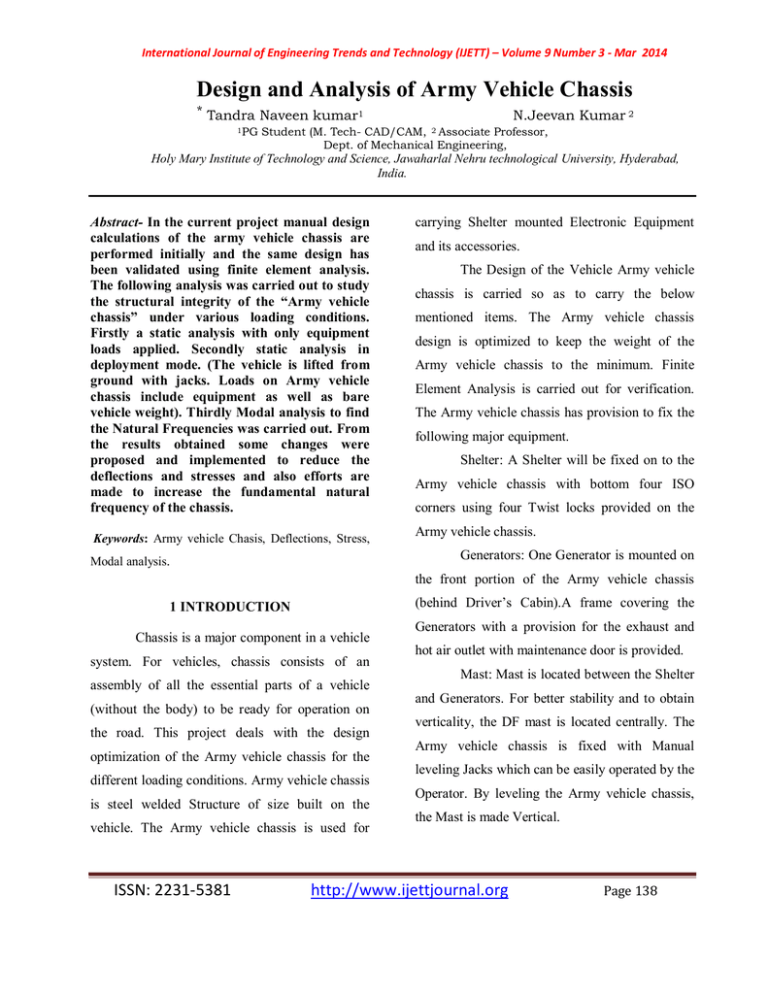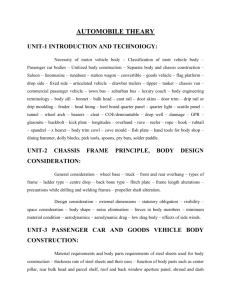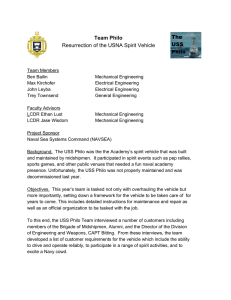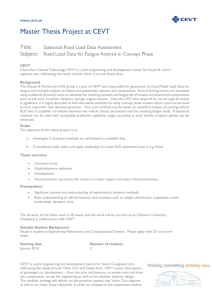Design and Analysis of Army Vehicle Chassis Tandra Naveen kumar N.Jeevan Kumar
advertisement

International Journal of Engineering Trends and Technology (IJETT) – Volume 9 Number 3 - Mar 2014 Design and Analysis of Army Vehicle Chassis * Tandra Naveen kumar1 1PG N.Jeevan Kumar 2 2 Associate Student (M. Tech- CAD/CAM, Professor, Dept. of Mechanical Engineering, Holy Mary Institute of Technology and Science, Jawaharlal Nehru technological University, Hyderabad, India. Abstract- In the current project manual design calculations of the army vehicle chassis are performed initially and the same design has been validated using finite element analysis. The following analysis was carried out to study the structural integrity of the “Army vehicle chassis” under various loading conditions. Firstly a static analysis with only equipment loads applied. Secondly static analysis in deployment mode. (The vehicle is lifted from ground with jacks. Loads on Army vehicle chassis include equipment as well as bare vehicle weight). Thirdly Modal analysis to find the Natural Frequencies was carried out. From the results obtained some changes were proposed and implemented to reduce the deflections and stresses and also efforts are made to increase the fundamental natural frequency of the chassis. Keywords: Army vehicle Chasis, Deflections, Stress, carrying Shelter mounted Electronic Equipment and its accessories. The Design of the Vehicle Army vehicle chassis is carried so as to carry the below mentioned items. The Army vehicle chassis design is optimized to keep the weight of the Army vehicle chassis to the minimum. Finite Element Analysis is carried out for verification. The Army vehicle chassis has provision to fix the following major equipment. Shelter: A Shelter will be fixed on to the Army vehicle chassis with bottom four ISO corners using four Twist locks provided on the Army vehicle chassis. Generators: One Generator is mounted on Modal analysis. the front portion of the Army vehicle chassis (behind Driver’s Cabin).A frame covering the 1 INTRODUCTION Chassis is a major component in a vehicle system. For vehicles, chassis consists of an assembly of all the essential parts of a vehicle (without the body) to be ready for operation on the road. This project deals with the design optimization of the Army vehicle chassis for the different loading conditions. Army vehicle chassis is steel welded Structure of size built on the vehicle. The Army vehicle chassis is used for ISSN: 2231-5381 Generators with a provision for the exhaust and hot air outlet with maintenance door is provided. Mast: Mast is located between the Shelter and Generators. For better stability and to obtain verticality, the DF mast is located centrally. The Army vehicle chassis is fixed with Manual leveling Jacks which can be easily operated by the Operator. By leveling the Army vehicle chassis, the Mast is made Vertical. http://www.ijettjournal.org Page 138 International Journal of Engineering Trends and Technology (IJETT) – Volume 9 Number 3 - Mar 2014 THEORITICAL CALCULATIONS: DESIGN CALCULATIONS OF ARMY Flange Thickness of C-Section (Ft3) = 4mm VEHICLE CHASSIS Shear load (σ) = 24 kg(f)/mm^2 Total Load on the Chassis (w) = 4 tons Weight trasmitted at each Point Load(W) = w*1000/4 = 4*1000/4 = 1000 kgs Distance between Rails(L) = 1582 mm Distance between Shaft Loading Moment of Inertia(MI6) = (w3*h3^3(w3-2*t3)*(h3-2Ft3)^3)/12 = 229775mm^4 Sectional Modulus(Z6) = MI6/h3/2 = 1823.61mm^3 Required Sectional Modulus of Long Member Box Section Brackets(Lb) =888mm Maximum Bending Moment(Bmax1) = w*(L-Lb)/2 = 1000*(1582888)/2=347000 Kg-mm Max Bending Moment(Bmax) = Bmax1/1000 = 347000/1000 =347 kg(f)m Required Sectional Modulus(Zr) = Bmax1/σ = 14458.33333 mm^3 Sectional Modulus of flat bed C Section for member of Chassis is constrained all the sides Shear load (σ) = 24 kg(f)/mm^2 Long Member Height of C-Section (h2) = 75 mm Width of C-Section (w2) = 40 mm Web Thickness of C-Section (t2) = 6 mm Flange Thickness of C-Section (Ft2) = Total Load on the Chassis (w) = 4 tons Distance between Rail Wheels along length (L) = 1582 mm 6mm Moment of Inertia(MI2) = (w2*h2^3(w2-2*t2)*(h2-2Ft2)^3)/12 = 697783.5 mm^4 Sectional Modulus(Z2) = MI6/h2/2 = 4651.89 mm^3 Considered Sectional Modulus of connecting flange Height of C-Section (h3) = 63 mm Width of C-Section (w3) = 25 mm Web Thickness of C-Section (t3) = 4 mm Distance between Roller Support and load Left Side (L1) = 653mm Length of Box Section (L2) = 2460 mm ISSN: 2231-5381 Considered type Cantilever as the long Distance between Roller Support and load Right Side (L2) = 653 mm Left Side Reaction(Rl) = w*1000/4 = 1000 Kgs Right Side Reaction(Rr)= w*1000/4 = 1000 Kgs Bending Moment Left Side(Bl) = Rl*L1 =1000*653 = 653000 Kg(f)-mm http://www.ijettjournal.org Page 139 International Journal of Engineering Trends and Technology (IJETT) – Volume 9 Number 3 - Mar 2014 Bending Moment Right Side(Br) = Rr*L2 = 1000*653= 653000 Kg(f)-mm Kgs Maximum Bending Moment on the long member (Bmax2) = Max(Bl, Br) = Max (653000, 653000) = 21531250 Kg(f)-mm Max Bending Moment(Bmb) = Bmax2/1000 = 653000/1000 = 653 kg(f)- Right Side Reaction(Rr)= w*1000/4 = 300 Kgs m Left Side Reaction(Rl) = w*1000/4 = 300 Bending Moment Left Side(Bl) = Rl*L1 =1000*300 = 120000 Kg(f)-mm Bending Moment Right Side(Br) = Rr*L2 = 1000*300= 120000 Kg(f)-mm Required Sectional Modulus(Z4) = Bmax2/ σ =653000/24 = 27208.33333 mm^3 Required Sectional Modulus of flat bed Box Maximum Bending Moment on the long member (Bmax2) = Max(Bl, Br) = Max (120000, 120000) = 120000Kg(f)-mm Max Bending Moment(Bmb) = Bmax2/1000 = 120000/1000 = 120 kg(f)- Section m Required Sectional Modulus(Z4) = Bmax2/ σ =120000/24 = 5000 mm^3 3D MODEL OF ARMY VEHICLE CHASSIS ASSEMBLY Considered type Cantilever as the long member of Chassis is constrained all the sides Shear load (σ) = 24 kg(f)/mm^2 Total Load on the Chassis (w) = 1.2 tons Distance between Rail Wheels along length (L) = 1576 mm Distance between Roller Support and load Left Side (L1) = 400mm Fig. 1 The 3D Model of army vehicle chassis assembly FINITE ELEMENT ANALYSIS Distance between Roller Support and load Right Side (L2) = 400 mm The material properties used for the design of Army vehicle chassis is given below. ISSN: 2231-5381 http://www.ijettjournal.org Page 140 International Journal of Engineering Trends and Technology (IJETT) – Volume 9 Number 3 - Mar 2014 Frame: This consists of C sections made from converted into a parasolid to import into ANSYS. wieldable quality hot-rolled structural steel IS: A Finite Element model was developed with shell 2062-1999, Grade A, Fe 410WA. and mass elements. The elements that are used for idealizing the Army vehicle chassis Assembly Mechanical Properties: were described below. A detailed Finite Element Tensile Strength = model was built with shell and mass elements to 410 Mpa idealize all the components of the Army vehicle Yield Strength = 250 Mpa Density = chassis. Modal analysis was carried out to find the 7850 kg/m3 first 6 natural frequencies and their mass participations. Changes were also implemented to The component weight is applied as Loads on the army vehicle chassis, the distribution of the load is shown in the below table. shift the fundamental natural frequency.The elements that are used for idealizing the Army vehicle chassis are Shell 63and Mass 21. Below Table-1 Shows the total Loads applied on the army vehicle chassis STATIC ANALYSIS FOR EQUIPMENT LOAD Total S.No Equipment Operators 1. Generator+Generator Cover 600 2. Battery Bank 400 3. Mast+Accessories 775 Weight(kg) Structural static analysis is performed on the army vehicle chassis by applying all the weights of the components which are mounted on the chassis. From the analysis the maximum stresses and deflections are identified and documented. The boundary conditions and loading applied on the chassis are shown in the 4. Flat bed 710 5. Shelter 1200 TOTAL 3685 below figure. FINITE ELEMENT MODELING: 3D model of the Army vehicle chassis assembly was developed in UNIGRAPHICS from the design calculations done. The model was then ISSN: 2231-5381 http://www.ijettjournal.org Page 141 International Journal of Engineering Trends and Technology (IJETT) – Volume 9 Number 3 - Mar 2014 STATIC ANALYSIS IN DEPLOYMENT MODE During deployment condition the vehicle is lifted from ground with jacks. The purpose of this condition is when the vehicle is on the slanting or rugged ground, the mast will becoming slant. To keep the mast always vertical the vehicle is lifted on the leveling jacks. During this condition Loads on Army vehicle chassis include equipment as well as bare vehicle weight and wind load. The boundary conditions and loading applied on the chassis are shown in the below figure. Fig. 2 Boundary conditions and loading conditions applied for static analysis Fig. 4 Boundary conditions and loading applied for static analysis in deployment condition Fig.3 Deflections and stress plots for static analysis ISSN: 2231-5381 http://www.ijettjournal.org Page 142 International Journal of Engineering Trends and Technology (IJETT) – Volume 9 Number 3 - Mar 2014 From the above results obtained in static analysis in deployment condition some high stressed locations were observed and to reduce the stresses additional C-sections were introduced as shown in the below figure. From the modal analysis it is also observed that there is a huge deflection at the center part of the chassis. To avoid this deflection and to increase the fundamental natural frequency an additional support structure is added as shown in the below figure. Fig. 5 Deflections and stress plots for static analysis during deployment MODAL ANALYSIS Modal analysis was carried out to determine the first 10 natural frequencies and mode shapes of a structure. A Block Lanczos mode-extraction method is used to extract the frequencies and mode shapes. Eigen values and their mass participations in all the three directions for the first 10 natural frequencies are listed in the below Table. Fig.7 Modifications made on the chassis Fig. 6 1st Mode shape@12.3Hz ISSN: 2231-5381 http://www.ijettjournal.org Page 143 International Journal of Engineering Trends and Technology (IJETT) – Volume 9 Number 3 - Mar 2014 MODE FREQUENCY PARTICIPATION FACTOR X-Dir Y-Dir Z-Dir 1 12.3 -5.37E-02 1.7289 -8.89E-02 2 18.2 0.31493 -5.46E-02 0.8925 3 19.9 -0.27852 -1.40E-03 -0.31352 4 29.1 0.89699 0.51368 0.11269 5 34.2 -1.1051 0.32009 0.88775 6 39.7 0.21158 -0.16863 0.6775 7 57.6 0.50195 0.12155 -0.11829 8 70.6 0.85297 -3.36E-02 0.39199 9 77.5 0.15373 3.47E-02 0.62358 10 83.5 0.19549 3.72E-03 1.03E-02 Table. 2 Eigenvalues and Mass participation in X, Y and Z directions EFFECTIVE MASS X-Dir Y-Dir Z-Dir 2.88E-03 2.98922 7.90E-03 9.92E-02 2.98E-03 0.79656 7.76E-02 1.96E-06 9.83E-02 0.80459 0.26387 1.27E-02 1.22122 0.10246 0.7881 4.48E-02 2.84E-02 0.45901 0.25195 1.48E-02 1.40E-02 0.72755 1.13E-03 0.15366 2.36E-02 1.20E-03 0.38885 3.82E-02 1.39E-05 1.06E-04 for the modified chassis as compared to the original one. RESULTS AND DISCUSSIONS In this project manual design calculations of the chassis are performed initially and the same design has been validated using finite element analysis. The following analyses were carried out to study the structural integrity of the “Army vehicle chassis” to identify the maximum stressed locations under various loading conditions. Modal analysis was also carried out to find the first 10 natural frequencies to understand the dynamic behavior of the structure. Based on the results some changes were proposed and implemented on the chassis. It was observed that there Fig.8 Comparison graph of natural frequencies for was a 65% reduction in the stress value and 50% original and modified chassis reduction in the total deflection for the static analysis CONCLUSIONS with equipment load condition. It was also observed that the there is a 21% Chassis is a major component in a vehicle reduction in the stress value and 20% reduction in the system. For vehicles, chassis consists of an assembly total deflection value for the static analysis in of all the essential parts of a vehicle (without the deployment condition. It was also observed that the body) to be ready for operation on the road. fundamental natural frequency is increased by 22% ISSN: 2231-5381 http://www.ijettjournal.org Page 144 International Journal of Engineering Trends and Technology (IJETT) – Volume 9 Number 3 - Mar 2014 In this paper the army vehicle chassis has Authors Profile: been designed and optimized to reduce the stresses Tandra Naveen kumar has performed this work while he is pursuing post graduation in CAD/CAM department at Holy Mary Institute of Technology and Science, Jawaharlal Nehru technological University, Hyderabad, India and deflections. Optimization was also done to increase the fundamental natural frequency. Initially the design was done with theoretical calculations. From the theoretical calculations the design was developed and the same design was validated using finite element analysis. Optimization was also done based on the finite element analysis results. From the finite element analysis results it is concluded that the optimized modified army vehicle N.JEEVAN KUMAR completed his B.TECH in year 1995 from NAGARJUNA UNIVERSITY and HE completed his M.TECH(CAD/CAM) in the year 2001 from JNTU,HYD. Now persuing Ph.D from OSMANIA UNIVERSITY. Having total 17 years of experiance .out of which 12 years of teaching and 5years of industry. chassis safe for the given operating conditions. References 1. 2. 3. 4. 5. 6. 7. Aird, Forbes. The Race Car Chassis. New York, New York: The Penguin Group, 2008. Gaffney, Edmund F., and Anthony R. Salinas."Introduction to Formula SAE Suspension and Frame Design." SAE Technical Paper Series, 1997 Riley, William B., and Albert R. George. "Design, Analysis, and Testing of a Formula SAE Chassis." SAE Technical Paper Series 01.3300, 2002 Milliken, William F., and Douglas L. Milliken. Race Car Vehicle Dynamics. Warrendale, PA: Society of Automotive Engineers, Inc., 1995 Cicek Karaoglu,N. Sefa Kuralay “Stress analysis of a truck chassis with riveted joints” Finite Elements in Analysis and Design 38 (2002) 1115–1130, Department of Mechanical Engineering, DEU Faculty of Engineering, 35100 Bornova, Izmir, Turkey. Mohd Azizi Muhammad Nora,b, Helmi Rashida, Wan Mohd Faizul Wan Mahyuddinb,Mohd Azuan Mohd Azlanc, Jamaluddin Mahmuda, “Stress Analysis of a Low Loader Chassis” International Symposium on Dr.R.Rajappan, M.Vivekanandhan,“ Static and Modal Analysis of Chassis by Using Fea” The International Journal Of Engineering And Science (Ijes) Volume 2, ssue 2,Page 63-73 (2013) ISSN: 2231-5381 http://www.ijettjournal.org Page 145




